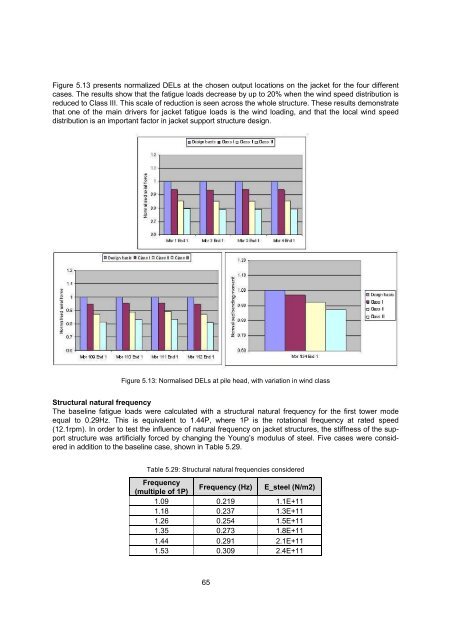Final report for WP4.3: Enhancement of design methods ... - Upwind
Final report for WP4.3: Enhancement of design methods ... - Upwind
Final report for WP4.3: Enhancement of design methods ... - Upwind
You also want an ePaper? Increase the reach of your titles
YUMPU automatically turns print PDFs into web optimized ePapers that Google loves.
Figure 5.13 presents normalized DELs at the chosen output locations on the jacket <strong>for</strong> the four different<br />
cases. The results show that the fatigue loads decrease by up to 20% when the wind speed distribution is<br />
reduced to Class III. This scale <strong>of</strong> reduction is seen across the whole structure. These results demonstrate<br />
that one <strong>of</strong> the main drivers <strong>for</strong> jacket fatigue loads is the wind loading, and that the local wind speed<br />
distribution is an important factor in jacket support structure <strong>design</strong>.<br />
Figure 5.13: Normalised DELs at pile head, with variation in wind class<br />
Structural natural frequency<br />
The baseline fatigue loads were calculated with a structural natural frequency <strong>for</strong> the first tower mode<br />
equal to 0.29Hz. This is equivalent to 1.44P, where 1P is the rotational frequency at rated speed<br />
(12.1rpm). In order to test the influence <strong>of</strong> natural frequency on jacket structures, the stiffness <strong>of</strong> the support<br />
structure was artificially <strong>for</strong>ced by changing the Young’s modulus <strong>of</strong> steel. Five cases were considered<br />
in addition to the baseline case, shown in Table 5.29.<br />
Table 5.29: Structural natural frequencies considered<br />
Frequency<br />
(multiple <strong>of</strong> 1P)<br />
Frequency (Hz) E_steel (N/m2)<br />
1.09 0.219 1.1E+11<br />
1.18 0.237 1.3E+11<br />
1.26 0.254 1.5E+11<br />
1.35 0.273 1.8E+11<br />
1.44 0.291 2.1E+11<br />
1.53 0.309 2.4E+11<br />
65











